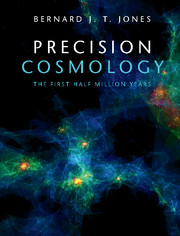Book contents
- Frontmatter
- Dedication
- Contents
- Preface
- Notation and Conventions
- Part I 100 Years of Cosmology
- Part II Newtonian Cosmology
- Part III Relativistic Cosmology
- 10 Minkowski Space
- 11 The Energy Momentum Tensor
- 12 General Relativity
- 13 Space-Time Geometry and Calculus
- 14 The Einstein Field Equations
- 15 Solutions of the Einstein Equations
- 16 The Robertson–Walker Solution
- 17 Congruences, Curvature and Raychaudhuri
- 18 Observing and Measuring the Universe
- Part IV The Physics of Matter and Radiation
- Part V Precision Tools for Precision Cosmology
- Appendix A SI, CGS and Planck Units
- Appendix B Magnitudes and Distances
- Appendix C Representing Vectors and Tensors
- Appendix D The Electromagnetic Field
- Appendix E Statistical Distributions
- Appendix F Functions on a Sphere
- Appendix G Acknowledgements
- References
- Index
18 - Observing and Measuring the Universe
from Part III - Relativistic Cosmology
Published online by Cambridge University Press: 04 May 2017
- Frontmatter
- Dedication
- Contents
- Preface
- Notation and Conventions
- Part I 100 Years of Cosmology
- Part II Newtonian Cosmology
- Part III Relativistic Cosmology
- 10 Minkowski Space
- 11 The Energy Momentum Tensor
- 12 General Relativity
- 13 Space-Time Geometry and Calculus
- 14 The Einstein Field Equations
- 15 Solutions of the Einstein Equations
- 16 The Robertson–Walker Solution
- 17 Congruences, Curvature and Raychaudhuri
- 18 Observing and Measuring the Universe
- Part IV The Physics of Matter and Radiation
- Part V Precision Tools for Precision Cosmology
- Appendix A SI, CGS and Planck Units
- Appendix B Magnitudes and Distances
- Appendix C Representing Vectors and Tensors
- Appendix D The Electromagnetic Field
- Appendix E Statistical Distributions
- Appendix F Functions on a Sphere
- Appendix G Acknowledgements
- References
- Index
Summary
In the Newtonian perspective, light simply moves in straight lines with constant velocity. The propagation of light through space was not an issue that Newtonian theory could address without making additional assumptions. In the curved geometry of Einstein's space-times, light responds to the ever changing curvature of the space-time.
In special relativity the light rays are defined by the fact that the proper distance moved by light is zero. This is enshrined in saying that light rays are the curves on which the line element is ds2 = 0. Given a coordinate system and a metric expressed in those coordinates, we can, in principle, solve the resulting equations. There is no reason to believe that our Minkowskian intuition about the propagation of light would be of help, and some of the results can at first be quite surprising. Like the result that the angular diameter subtended by an object of fixed size can increase with distance!
Aside from this counter intuitive behaviour there is another problem: the problem of understanding and interpreting the coordinates in terms of what a person sitting in an inertial frame observes. This is fundamental to the astronomer observing the Universe, and so we develop the relevant equation for an FLRW Universe.
Light Propagation in Curved Space-Time
Understanding the physics of light propagation is a vital step in interpreting the observed cosmological redshift. Getting to understand the redshift was not at all straightforward even though it is a consequence of the cosmological models constructed within the context of general relativity. Some of this early story with regard to de Sitter's Universe was retold in Section 15.6.4.
As late as the 1960s and 1970s there was still an active, and often heated, debate as to whether the observed redshifts of galaxies and quasars were of cosmological origin. That was not simply a question of whether or not general relativity could provide the explanation for the phenomenon. The debate was more about whether there was an additional contribution from phenomena intrinsic to the source or from something that might happen along the path of the light rays (as in ‘tired light’). Some of the debate even suggested that the constants of nature might be a function of time, an idea that originated with Dirac (1937, 1938) following up on earlier ideas of Milne and Eddington.
- Type
- Chapter
- Information
- Precision CosmologyThe First Half Million Years, pp. 428 - 448Publisher: Cambridge University PressPrint publication year: 2017



